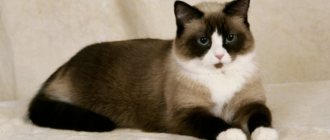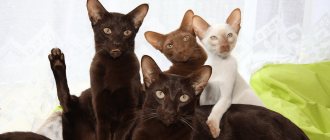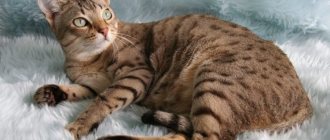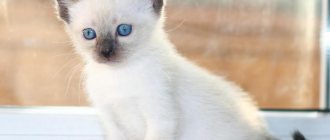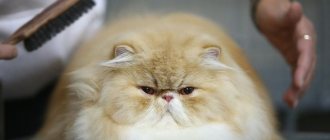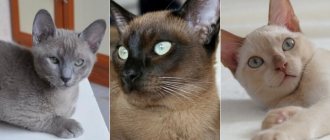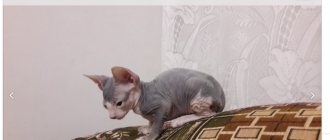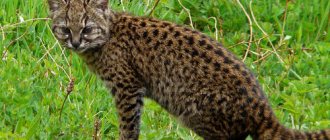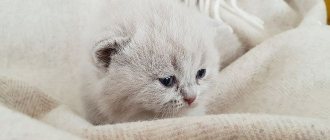If you ask people who have chosen a Ragamuffin cat, you will hear the following reviews: a simple and wonderful pet, a sociable and loyal friend, a healthy and imposing pet - all this is combined in a beautiful, affectionate animal. A simple origin story does Ragamuffin cat very close and understandable. The bright, impressive appearance, so characteristic of this breed, pleases owners and attracts everyone's attention at every cat show.
Brief history of the breed
The Ragamuffin is a relatively young cat breed. The reason for starting work on its breeding was a disagreement between the American breeder Anne Baker and a group of felinologists - they did not agree on the breeding of ragdolls.
The breeder was the first to patent the rights to this breed and established numerous restrictions on everything related to breeding activities and registration of litters in any felinological organizations with the exception of IRCA.
This was the reason that in 1994 there was a split in the ranks of ragdoll lovers. A group of breeders who left the IRCA began large-scale work to update the breed. Ragdolls began to be crossed with Persians, Himalayans and outbred cats.
The offspring obtained from such matings gave rise to a new breed. She was named ragamuffin, which translated from English means “ragamuffin” or “tramp”. In 2004, these fluffy cats received CFA recognition, and in 2011 they were allowed to compete for championship titles.
Features of mating and breeding
The breed remains one of the rarest, and there are still no nurseries breeding Ragamuffins in post-Soviet territory. Breeders who specialize in ragdolls are showing interest in this breed. Breeding work with the new breed is hampered by two main factors: firstly, there is no sufficient gene pool, and secondly, there is no demand for the cute, but very expensive kittens of this little-known Ragamuffin.
The population of ragamuffins is limited, and choosing a parent pair is a considerable problem
Ragamuffins are recommended to be bred no earlier than three years of age, although even by this age the formation of animals is not yet completely completed. Cats of this breed are unusually delicate even in matters of love - they can care for a cat platonically for a very long time before daring to take more decisive actions. There are no other reproductive problems in the breed: matings are usually successful, cats tolerate pregnancy well and give birth easily.
Newborn Ragamuffin kittens are always white
Litters are often multiple and delight the eye with a variety of colors. Ragamuffin kittens are born completely white, the color spots begin to appear gradually, from the first days of life to six months. Babies develop more slowly than in other breeds.
One litter can have kittens of different colors
Only adult, absolutely healthy animals, vaccinated and treated for parasites, are allowed for breeding, which must be marked accordingly in the veterinary passport. Both producers must have certificates of breed conformity entered in the register of the felinological organization where these animals are registered. Interbreed matings are not allowed. The optimal age for castration or sterilization is about a year.
Sterilizing a cat is a abdominal operation that requires serious rehabilitation.
Interesting Facts
During the short period of existence of ragamuffins, many interesting things have been associated with them:
- Cats of this breed have a very gentle character. Therefore, American breeders gave them the playful nickname sweet muffins, which translated from English means “sweet cupcake.” Ragamuffins are also called Teddy bears in the form of a cat.
- Among the representatives of this breed there are many heavyweights, whose body weight exceeds 9-10 kg.
- With age, the fluffy fur of Ragamuffins changes structure and loses its natural shine. The cat's coat becomes more porous and dull. Therefore, representatives of the breed look much darker in old age.
Diseases and defects of the breed
Since the ancestors of Ragamuffins were “hardened” street cats, their descendants are not prone to diseases. Hereditary diseases are also rare among these cats. Therefore, such pets live on average 16–18 years.
Regular visits to the veterinarian will ensure the health and longevity of the Ragamuffin
At the same time, the following ailments occur among representatives of these felines:
- polycystic kidney disease - when cysts grow in these organs and fluid accumulates, as a result of which the pet needs systematic detoxification and symptomatic measures;
- hypertrophic cardiomyopathy - characterized by enlargement of the heart muscle and develops regardless of age, but is more common in older individuals;
- hip dysplasia - found in young animals and is a lack of articulation between the pelvis and the femur.
Like other cats, Ragamuffins can become infected with worms, so it is important to have your cat checked regularly by a veterinarian.
Preventive vaccinations are given starting at the age of three months. Vaccination includes protective measures against influenza and enteritis, as well as prevention of leukemia (if the cat is often outdoors).
The defects of the breed, due to which Ragamuffins are not allowed to compete, include:
- squat body and protruding vertebrae;
- shortened tail with kinks or sparse hair;
- slanted eyes and small ears;
- excessively flattened nose;
- sparse “collar” on the neck and missing “pants” on the hind legs;
- the coat is darker and duller than usual.
Such deviations are strictly monitored by the CFA system and become the reason for the disqualification of cats at exhibitions.
Breed description, standards, appearance
Ragamuffins are heavy, harmoniously developed, fluffy cats with massive bones and a layer of fat in the abdominal area, giving the silhouette a slight roundness. The admixture of Persian blood is almost invisible in their appearance, but their relationship with Ragdolls is clearly visible.
Dimensions and weight
Ragamuffins are large animals with moderate sexual dimorphism. A cat of this breed weighs between 5-7.5 kg. The weight of an adult cat is 5-10 kg.
Anatomical characteristics
A typical representative of the breed should meet the following description:
- The head is wedge-shaped, with soft, slightly convex contours, a strong chin and well-filled cheeks. At the transition from the forehead to the short oval muzzle there is a visible deflection.
- The ears are small, moderately wide at the base. Slightly inclined forward, covered with short hair on the outside.
- The eyes are large, widely set, with an open, friendly look. Ragamuffins with mink coloring should only have blue irises. Individuals with sepia tones may have yellow, golden, or green eyes. In ragamuffins with a different color, any color of the iris and even heterochromia are allowed.
- The body is medium in size, compact with a layer of fat in the lower abdomen, a flat back and a rounded wide chest. Neck muscles become more pronounced with age. This is especially noticeable in cats.
- The limbs are strong, with heavy bones and large round paws. The hind legs are slightly longer than the front ones. There are tufts of soft wool in the interdigital space.
- The tail is proportional to the body, of medium thickness, slightly tapering towards the tip. Covered with light long hair, giving it a plume-like appearance.
Color and coat type
The Ragamuffin is a fluffy cat with a dense, silky coat reminiscent of rabbit fur. The length of the outer hair varies in different parts of the body. The spine is short on the sides and belly. The cat's back, crown and shoulder blades are covered with longer hair.
The Ragamuffin standard allows for any colors. But breeders working in the CFA system give preference to tabbies and bicolors and cull color-point individuals. Of the solid colors, the rarest and most valuable are white and black coat colors.
Possible breed defects
Flaws in appearance, in the presence of which the ragamuffin will not receive a high expert rating:
- tail defects;
- color-point color;
- short hair;
- polydactyly;
- strabismus.
Description
Ragamuffins are large cats weighing from 6 (females) to 10 (males) kilograms.
The muscular, powerfully built body of these cats looks somewhat elongated.
The limbs are slender, short, with small compact hands.
The tail is long, extremely bushy, and tapers evenly from base to tip.
A large head with plump cheeks and a rounded muzzle.
The ears are small, widely set, and some individuals have perky tassels. This suits them very well.
The eyes are large, most often round or oval in shape. The shade can be any: green, golden yellow, blue, aquamarine or blue. There are animals with eyes of different colors. When breeding this breed, it is not so much the color that is important, but its brightness and expressiveness of the look.
Wool is a source of special pride for Ragamuffins. Very long, with a thick dense undercoat, it resembles rabbit fur. The fluffy tail and gorgeous collar look especially chic.
Unlike ragdolls, ragamuffins can have any color: colorpoint, tabby, bicolor and many other options. For these cats, the quality of the coat is much more important.
Ragamuffins live up to 15 years.
Character and temperament
Ragamuffins are affectionate and good-natured cats; they value comfort and do not strive for independence. They are not prone to displays of aggression, pride or suspicion. And the most favorite pastime of fluffy ragamuffins is relaxing on their owner’s lap.
On a note. Ragamuffins quickly and forever become attached to their first owners. Therefore, adult cats of this breed cannot be given to other people. They will always miss their previous owners and will not be able to get used to the new environment.
The friendly and non-conflict nature of these fluffy cats allows them to easily find a common language with children, especially if they do not offend them. Kind and somewhat phlegmatic Ragamuffins do not refuse to be “living dolls.” Fluffy pets stoically endure dressing up in different outfits and riding in toy strollers.
Representatives of the breed get along well with other cats, but provided that they do not compete with them for their owner's attention. Ragamuffins are completely devoid of hunting instincts and live without problems next to ornamental rodents and birds.
Cost of Ragamuffin kittens and where to buy them?
The cost of Ragamuffin kittens primarily depends on the pedigree. Those who decide to have such a pet will most likely have to shell out a large amount of money for it. The fact is that the breed is not recognized by all felinological organizations. It is bred by a very small circle of breeders.
If you look at foreign nurseries, the cost of a Ragamuffin kitten is about 57 thousand rubles.
The main nurseries of this breed are located in the USA. There are also registered representatives in Canada, Austria, England, the Netherlands and South Korea. There are no such nurseries in the CIS countries. It is possible that ragdoll breeders are engaged in private breeding of ragamuffins. There are a lot of them in Russia.
How to choose the right kitten
Ragamuffins are quite rare and expensive cats. Therefore, you need to buy them only from trusted breeders or certified nurseries, the largest of which are concentrated in the USA. Before purchasing, it is recommended to make sure that you have documents about the breed and evaluate how well the fluffy kitten’s appearance meets the standard.
First of all, you need to pay attention to the eye color of the little Ragamuffin. The richer and brighter the shade of the iris, the better. Purebred kittens have a strong rectangular chest, a long tail and powerful hind legs.
On a note. All Ragamuffin kittens are born with white fur. Their future color begins to appear as they grow older. Therefore, you should buy a baby of this breed no earlier than 16 weeks of age.
Kitten care
Typically, kittens of this breed are booked in advance, which means that future owners have enough time to prepare their home for the arrival of their furry pet. For him they buy:
- bowls for food and water;
- grooming tools;
- hygienic cosmetics;
- toys;
- bed;
- scratching post;
- tray and filler.
To prevent the kitten from being injured in the process of exploring a new place of residence, small objects, indoor plants, household chemicals and wires are removed from it. Also, for safety reasons, the little Ragamuffin is denied access to open windows and large appliances such as ovens and washing machines.
To prevent digestive problems associated with stress from a change of environment, at first the fluffy kitten is fed what he is accustomed to from the breeder. New foods are introduced into the little Ragamuffin’s diet gradually, carefully observing the reaction of his body. The feeding regimen is selected taking into account the age of the pet:
- up to 3 months – 5-6 times a day;
- 3-6 months – 4 times a day;
- 6-12 months – 3 times a day.
From the age of one year, Ragamuffin is transferred to twice feeding.
Ragamuffin content
Maintaining the health of your furry pet comes down to choosing a balanced diet and regular hygiene procedures.
Feeding
Since Ragamuffins are large breeds of cats and tend to be overweight, you should prepare a balanced diet for your pet.
Obesity is a common problem among Ragamuffins
It is best to give preference to ready-made food containing duck, chicken or salmon. The class of food you choose is also of no small importance - the highest quality products are marked “Super-premium” and are ideal for your furry pet. Such food has already calculated the daily food intake and contains all the vitamins the cat needs.
Other nuances of the ragamuffin feeding regime will be:
- exclusion from the menu of flour, sweet dishes and too fatty foods;
- inclusion in natural food of boiled sea fish without bones, low-fat and unsalted soups, cereals and dietary meat (turkey, veal);
- adding calcium to food when eating natural food;
- regular cleansing of the intestines from swallowed wool with maltose paste;
- supplementing the diet with vitamin complexes in the absence of ready-made food.
The last rule is mandatory, since due to the long hair and large build, the Ragamuffin’s body requires a lot of useful substances and microelements.
The animal should be fed no more than twice a day to avoid obesity. The daily food intake is calculated based on the weight of the tailed animal at the moment of life and is 5% of body weight.
In addition, the cat should have clean drinking water at all times, which can be conveniently placed in a drinking bowl with a special nipple. This way, particles of wool will not fall into the source, and the fur coat will remain dry and beautiful.
Taking care of appearance
Caring for these long-haired cats does not differ much from the rules for keeping other domestic purrs. In addition, tailed “cherubs” are so devoted to their owner that they do not resist any cosmetic procedures, be it combing or trimming their claws.
Ragamuffins need to be taught to use a scratching post from childhood.
Despite the fact that representatives of the breed have a long and thick coat, the latter does not need to be combed too often. The structure of ragamuffin fur resembles that of a rabbit and practically does not form tangles. Therefore, it is enough to comb cats once a week using a metal comb with elongated teeth. However, efforts should be doubled during molting, which occurs in spring and autumn. The animal must be accustomed to this procedure from infancy, so that in the future the purr does not show resistance.
Ragamuffins are bathed at least once a year. It’s even better if the cat takes a bath every six months. Especially if your pet's fur is prone to excessive oiliness. Cats of this breed do not like water. But they do not show strong protest, because they completely trust the owner.
Before bathing, it is important to comb out the fur coat and plug the ears with cotton swabs. The muzzle should be wiped with a damp cloth.
During the water procedure, you need to ensure that all areas of the fur coat are completely wet and soapy. After which it is important to rinse the wool thoroughly. Dry the ragamuffins with a hairdryer and a comb, so that the pieces of fur do not stick together or become crumpled into tangles.
These furry pets' nails should be trimmed or filed. At a young age, the procedure is done once every two weeks, and for adult cats - every 20 days.
And in order to avoid periodontal disease, you need to clean your mouth and teeth daily from plaque and food debris. This is done using a special brush and paste for cats.
Other nuances
Although Ragamuffins are considered completely domestic animals, outdoor exercise is important for these cats. Especially in the warm season.
The Ragamuffin must be trained to use a leash from childhood.
To ensure safety, you should introduce your pet to a leash or harness in advance. As a rule, thanks to their calm and obedient disposition, fluffies easily get accustomed to such an accessory, especially at a young age.
Another point worth paying attention to is training your cat to use the litter box. Problems in this area will not arise if the requirements are explained to the animal immediately upon arrival from the nursery. The tray needs to be installed in a strictly defined corner of the house and the pet should be systematically brought into it at the first sign of looking for a place to relieve itself.
The size of the toilet should be large - to match the dimensions of the ragamuffin. Preference should be given to an open model so that the animal can easily fit into such a tray.
It is better to choose the filler in the form of large balls so that the granules do not get tangled in the cat’s fur.
Care and maintenance
A Ragamuffin cat can live both in an apartment and in a private house. True, he is not able to stand up for himself, so it is better not to let your furry pet outside unattended.
To make the ragamuffin look aesthetically pleasing, it is provided with proper care:
- The eyes and ears of a fluffy cat are periodically wiped with a cotton swab dipped in a special lotion or boiled water. They are also examined for the presence of unusual discharge. If pus is detected, Ragamuffin is taken to a veterinarian.
- As they grow, the cat's claws are shortened with a nail clipper, removing only the transparent part. The procedure is carried out as carefully as possible so as not to injure living tissues and not cause pain to the ragamuffin.
- The teeth of a fluffy cat are brushed 3-4 times a month with a silicone brush and a special attachment with a small amount of non-foaming paste.
- The Ragamuffin's shaggy fur does not tangle. To keep your fluffy cat looking neat, she should be brushed regularly with a long-toothed brush. In normal times, this is done 2-3 times a week, and during the molting period - daily. Ragamuffins are bathed no more than 3-4 times a year. To do this, use special shampoos for long-haired breeds.
Important! Ragamuffins are real clean people. But in the process of licking their fur coat, these fluffy cats swallow the fur. Therefore, they are given a special paste every month to dissolve hairballs in the stomach.
Nutrition
It is better to use professional balanced food for long-haired cats. If you give natural food, be sure to add vitamins and minerals. Don’t forget about a special paste that “breaks up” hairballs in the stomach.
Animals of this breed are predisposed to gaining weight, even becoming obese, so it is important to control the quantity and quality of food. Eliminate from your diet everything fatty, floury, sweet, and especially spicy. Don't give him food from your table at all. Human food is harmful to cats.
It is better to cook him separately or give him some raw foods. For example, it is better to give lean and raw meat - chicken breast, turkey, and boiled fish. Include fermented milk products, eggs and green grass in your diet. Give foods that can cause allergies with caution. It is a good idea to add calcium to your food to strengthen your bones. And don’t forget to change the water on time.
Feeding the cat
Because Ragamuffins have fluffy fur that gets dirty when they eat, it is recommended that they be given commercial food. For cats of this breed, it is advisable to buy premium or super-premium drying, which does not contain soy, dyes or preservatives.
These requirements are best met by the following brands:
- Pronature;
- Bosch;
- Hills;
- Grandorf.
Important! Dry-fed ragamuffins should have easy access to clean drinking water.
With a natural type of feeding, the menu for fluffy cats is designed so that it contains at least 70-80% meat. Ragamuffins are also given:
- boiled vegetables;
- porridge with water;
- boiled eggs;
- offal;
- sour milk;
- sea or ocean fish.
In order for cats of this breed to remain healthy and active longer, they should not be given pork, fresh milk, pastries, sweets and smoked foods. Also, ragamuffins should not be fed sausages, pickles, river fish, potatoes and leftovers from the owner's plate.
Education and physical activity
Ragamuffins are intelligent cats and can be trained well. Fluffy representatives of the breed try to please their owners in everything and quickly remember the rules of behavior in the house. If desired, ragamuffins can even be taught basic commands and simple acrobatic tricks.
Despite their slightly phlegmatic temperament, Ragamuffins will not refuse to run after a ball or a laser pointer. To ensure that fluffy cats have the opportunity to maintain physical fitness, they are equipped with a special corner with multi-level areas and bought interactive toys.
Features and upbringing
The temperament and behavioral reactions of the “Ragged Man” are admirable; the original name “Cherub” would have suited this animal better. Cats are simply ideal in terms of their level of love and affection for humans. They have a number of features that you should remember before purchasing them:
- Does not allow rivalry. If a new pet appears in the house, the “Ragged Man” will accept him favorably and even become friends. But at the same time, his role should remain dominant. The owner should remember this and always distinguish his furry friend from other animals. You should not bring a cat into a house where there are other pets; you need to give it time to get comfortable on its own and feel unity with its owner.
- There is absolutely no “hunter” gene. Apparently this is caused by a gene mutation when crossing different breed lines. This cat will quickly disappear on the street, simply die of hunger. If there is a small child in the house and you cannot keep him from “hunting” for the pet, then it is better to wait until the children grow up and are aware of their actions. The “ragamuffin” will never refuse to play with children, will sincerely love and protect them, but will not be able to stand up for himself. It allows you to do whatever you want with you - carry it in your arms, swaddle it, roll it in a stroller. The main thing is for children to understand that this is not a living toy, but a friend.
- Cats of this breed do not tolerate insults. They cannot be punished, their voices cannot be raised at them, and, moreover, physical violence must not be used. They are so devoted to a person that they fall into severe stress from grief.
- But most of all, “Ragged People” suffer from loneliness. Remember that your delicate pet should not be left alone for long. The animal may even die from longing for its owner.
In all other respects, these sweetest creatures will bring only joy to your home. Ideal for single people and close-knit families. Absolutely non-aggressive, highly intelligent and easy to train.
Vaccinations and antiparasitic treatment
To prevent viral and infectious diseases, ragamuffins are regularly vaccinated against panleukopenia, rhinotracheitis and calcivirosis. The first vaccination is given to a fluffy kitten at 7-8 weeks.
After 28 days, a small representative of the breed is vaccinated against the same diseases and against rabies. Subsequently, ragamuffins are vaccinated once a year.
To prevent diseases carried by parasites, furry cats are periodically treated for fleas and worms. Anthelmintic drugs are given to ragamuffins strictly by weight 2 times a year with mandatory repetition after 10-14 days.
To combat external parasites, special shampoos or drops are used. And if the Ragamuffin goes on walks, it is additionally protected with an anti-flea collar.
Ragamuffin breeding
Initially, the founder of the breed, Anne Baker, was involved in the breeding of these long-haired cats. Since the process got out of the control of the breeder, ragamuffins began to spread in both the USA and European countries. However, such purrs are still not very well known in Russia. And they get divorced mostly privately.
Ragamuffin breeding is a rare phenomenon in the CIS countries
To receive an inheritance from your pet, you need to follow a strict rule - cross the animal only with a partner of the same breed or with a representative of the Ragdoll breed. However, CFA standards allow you to choose long-haired Selkirk Rex dogs as a pair until 2030.
Puberty in ragamuffins occurs late - at four years of age. Then the purr is given for the first mating.
Ragamuffins are often crossed with Ragdolls due to the lack of partners of the same breed in the immediate environment.
The ragamuffin cat's pregnancy lasts 65–70 days, resulting in white kittens. Over time, the individual color of the fur coat appears - starting from the 8th week of life.
To prevent the female from having health problems, it is better for your furry pet to give birth no more than three times a year. Moreover, at this time you need to monitor your cat’s health more carefully than usual, double the amount of vitamins and regularly monitor it with a veterinarian. After giving birth, it is advisable for ragamuffins to undergo a course of restorative therapy, especially if the delivery was complicated.
Pros and cons of the breed
Ragamuffins, like cats of any other breed, have both advantages and disadvantages:
| pros | Minuses |
| Pleasant appearance | Heavy shedding |
| Good-natured disposition | Tendency to depression |
| High intelligence | Failure to protect yourself |
Ragamuffins are attractive cats with fluffy fur coats and the habits of a true intellectual. Their beautiful appearance, non-conflict disposition and boundless patience make them ideal pets for families with children who spend a lot of time at home.
Walks and bling for games
In some ways, these cats are completely different from their relatives - they do not know the feeling of fear. They simply do not understand that there are people and animals that can harm them. Ragamuffins do not require daily walks, but when a cat finds itself outside, it is better if its owner is next to it; these cute cats are simply unable to protect themselves.
The calm nature of these cats does not mean that they do not like to play. Ragamuffins enjoy climbing on the scratching post, running after toys and playing with objects they like. But the favorite pastime of representatives of this breed remains general relaxation with their owners, to whom they are attached like children.


